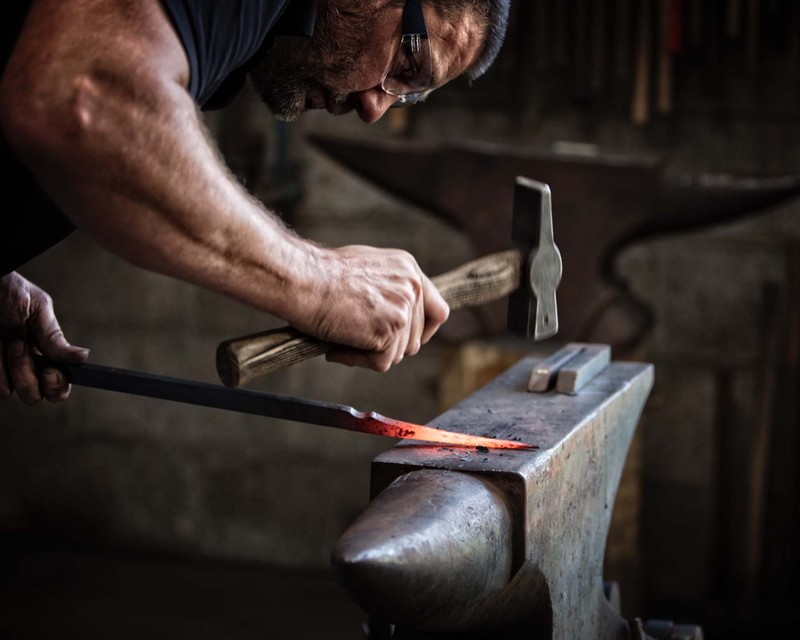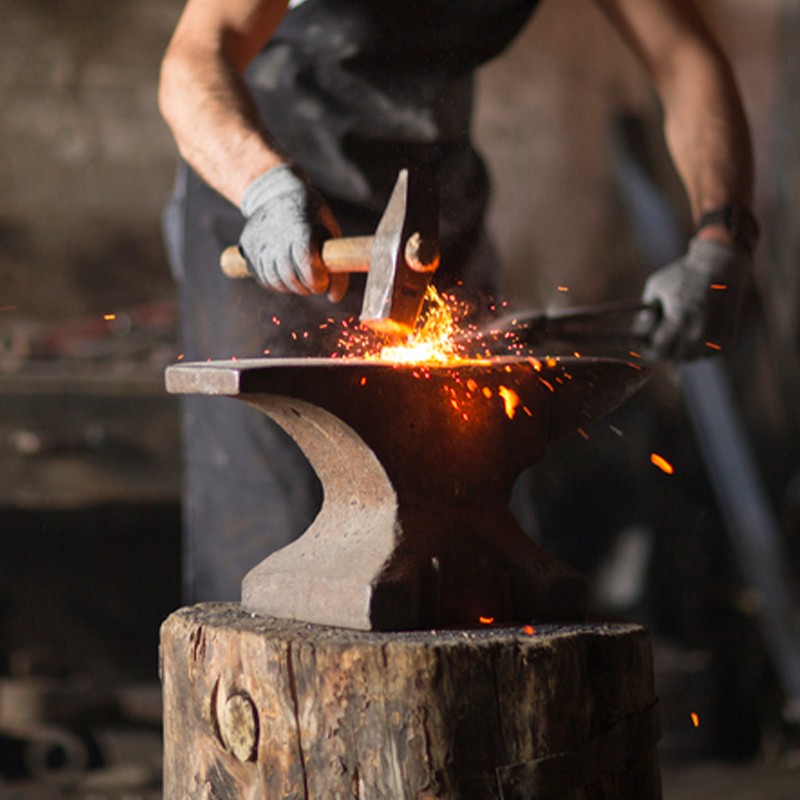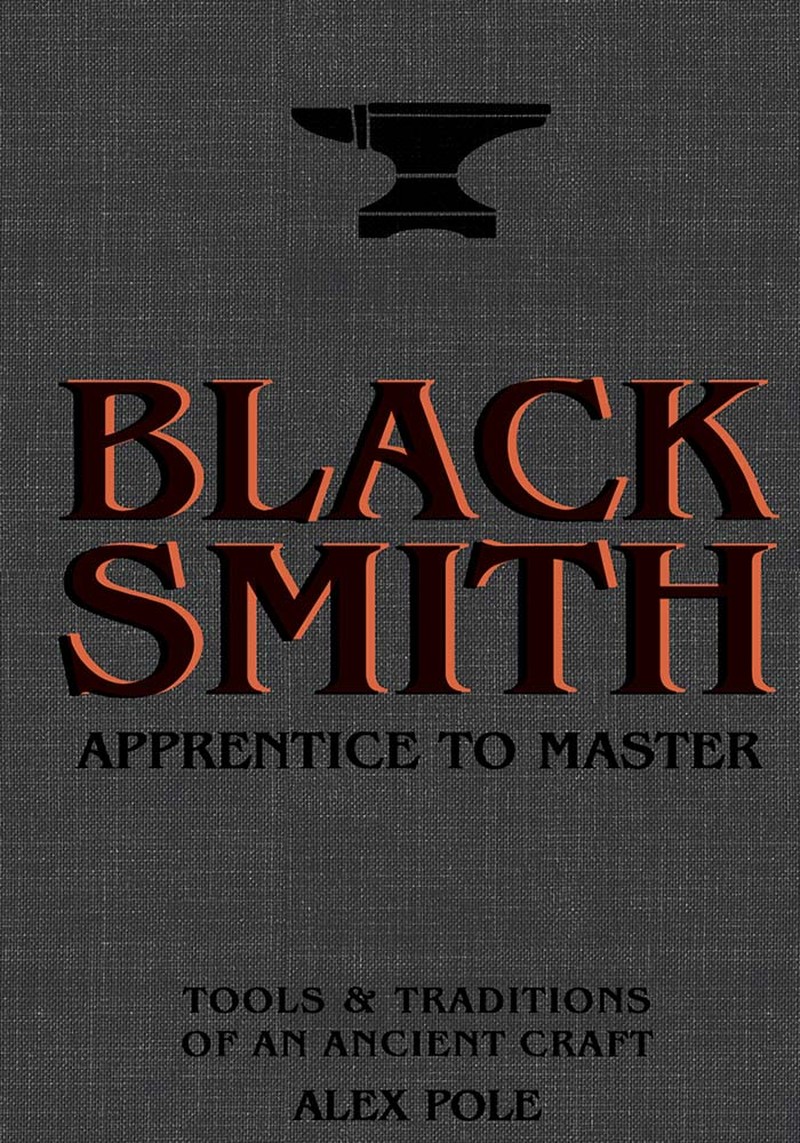My Interesting Job: Blacksmith
So what does a blacksmith actually do, Alex?
In the very simplest terms, ‘smith’ comes from the German word ‘schneider’ which means someone who works with a particular material. A blacksmith works with iron, which is also known as ‘black steel’. Working with iron means heating it to about 1,000ºC in a forge and repeatedly striking it against an anvil until you get the shape you want. And that’s what a blacksmith does: uses their body, their will and their artistic desire to manipulate hot steel.
It’s a trade that conjures images of burly medieval men getting sweaty in fairly hellish conditions… Are there many of you out there today?
It’s hard to quantify – I tried to do it recently – but I think there are about 400 registered blacksmiths in the UK and probably hundreds more hobbyists. And those figures are going up – at the moment blacksmithing is probably enjoying its biggest revival since before the industrial revolution.
What do you actually make?
We don’t do anything else apart from kitchenware – no shoeing of horses, no making railings – so it’s restaurant businesses mainly. They tend to want cookware – frying pans, skillets, barbecues, as well as serving utensils. But we also do special projects with chefs. I’ve just been working with Jeremy Chan at Ikoyi. He wanted a dish specifically for presenting just one small piece of salmon on his menu. At the other end of the spectrum, we’re making 800 pieces of cutlery for another establishment.
What makes a good blacksmith? Massive forearms?
Being able to take instruction, so you can really learn. And tenacity, so you can practise something over and over again. Sometimes we will hit something hard 30,000 times in a day. In terms of the physical stuff, we like to kick against the blacksmith clichés of being massive blokes with beards and leather aprons, and show that we’re much more modern than that. I run the business from my iPhone, we’ve got a great, efficient website, social media is important to us, and so on.
The truth is, though, I’m 6’6” and my head smith is an ex-gymnast and martial arts guy. He’s ripped like you wouldn’t believe. Most of them go to the gym because it’s a good way to work out the stresses of the day, but the physical stuff isn’t the most important thing. Anyone can hit a nail with a hammer.
And what are pay and conditions like now?
It’s actually hard to say how much they’ve changed. In terms of pay, contrary to popular images of downtrodden men, blacksmiths were revered as highly prized craftsmen. Kings often had their blacksmiths sitting with the nobility at their high table. These days, I can say I pay my guys handsomely – well above any living wage – and we have very good working conditions. There are health and safety regulations, of course, and lots of perks. Just this weekend, two of my guys are going into the workshop to use the tools and make their own stuff. However, yes, it’s still incredibly hot, incredibly sweaty, dirty and loud. It’s good, hard physical labour that a lot of people seem to have lost touch with nowadays. There are lots of cuts and burns, but they’re no worse than what a gardener gets from digging a patch of nettles or cutting himself on a branch.
It sounds rewarding…
It is. I think there are probably three different rewards. There’s the creative reward of the process, of using your body and mind to crush, squish and manipulate metal. In fact, we have an 80:20 rule in the forge. There’s always about 20% of any job that’s a bit boring or monotonous, but if we find we’re not enjoying the process of making something – if that 20% figure gets too high – we stop making it. We’re in the workshop so many hours that we need to enjoy the process. The second reward is the end result – the satisfying outcome of that process. And the third, of course, is the financial reward. We’re not ashamed to make money. I want to run a successful business, so that I can pay my guys more and buy more tools – we’re all quite heavily addicted to tools.
Is there such a thing as a typical day in the workshop?
Not really. In industry speak, we’re production blacksmiths, which means we run a medieval-style forge (or smithy) and produce repetitive items. We don’t just make one item and that’s it. We specialise in kitchenware and we produce lots of pieces in an order. Depending on what’s going on, we tend to have a team meeting in the morning as we kick up the forges – they take a little time to heat up. Once they’re ready, the rest of the day is basically at the forge, with tea and lunch breaks. We change what everyone does regularly, so no one gets bored – if you spend four or five hours working on the same thing, you can go down a bit of a rabbit hole.

How did you come to be a blacksmith?
After I left school, I travelled for quite a long time before coming back to start an architecture degree at what was the Polytechnic of Central London. I failed – I’m fantastically dyslexic – but I got to do some modules in jewellery as part of the course. I walked into the jewellery workshop and it was one of those blinding, road-to-Damascus moments. It still gives me goosebumps 30 years later – I knew this was what I wanted to do. I gave up, left London and went to art college in Plymouth to do a four-year course in metalwork. Then I spent another almost 15 years travelling – France, Spain, working as a jeweller and blacksmith in Australia – before I came back to the UK in 2007 and set up Alex Pole Ironwork.
Is there a more usual route to becoming a blacksmith?
A traditional apprenticeship is seven years. You know the 10,000 hours rule for mastering something? That definitely applies here. After the seven years, you become a journeyman blacksmith. Then it could be 10, 15, 20 years before you become a master blacksmith.
Are you a master?
No. I’m sort of unclassified because I didn’t do a traditional apprenticeship, but really I’m a journeyman. I’m not technically good enough to be a master – I haven’t got the patience. One of my guys, Joe, is 25 and he’s already a better technical blacksmith than me. We complement each other though – in my 50s, I’m much more interested in the design and aesthetics of what we make, rather than actually making it myself.
Looking ahead then, where do you want to be in five or ten years’ time?
I'm not much of one for planning and I think the last couple of years have shown the main thing you need to be is adaptable. We have ideas for the business – we want to make more axes and we want to do more teaching – but we’re not really looking that far ahead. I just want the business to be the best it can be, and I’d love to create a brand or an organisation or a school of thought that cuts a swathe through the technological world we live in. I want to show that people can still make things as a counterpoint to us all spending our time in front of screens.
And what about blacksmithing as a craft? It sounds like the future is quite bright…
I think there's an inherent desire within humans for handcrafted items and beautifully made objects, and that's never going to go away. That desire – that counterpoint I spoke about – seems to be becoming more mainstream. As it becomes more mainstream, we just have to be careful that we retain that authentic sense of things being handcrafted. Just the other day, I saw a bloke driving around in a van that said ‘traditional blacksmith’. I looked up his business and all he does is import goods from China and sell them on. No blacksmithing involved.
I think we also have another inherent desire – to make things ourselves. Making things can give us a sense of self-worth. There’s an opportunity for blacksmiths – and masons and carpenters and others with the same mentality – to meet this need. We just need to find the right way to marry technology and tradition to keep our crafts alive. That doesn’t mean I want us to go back to using hand-pumped bellows – it means I want us to protect the techniques we use that are thousands of years old. Because they still have value today.
DISCLAIMER: We endeavour to always credit the correct original source of every image we use. If you think a credit may be incorrect, please contact us at [email protected].



